Affiliated with:
University of Wisconsin Lacrosse
Published:
April 27, 2007
General Description
The giant squid or Architeuthis dux comes from the class of mollusks know as Cephalopoda. They are the largest invertebrate to exist with a total length of between 10-12 meters and weigh up to 900kg. For those of you who need help visualizing this they are about the size or a school bus. In addition to their lengthy bodies they have two feeding tentacles which are between 10-12 meters in length.
 The Architeuthis dux club like tentacles
are massive weapons which are separated into three
separate sections; the carpus, manus, and dactylus. On the ends of the arms are
the manus which are outfitted with large spherical suckers made of sharp serrated
chitin used in defense and catching prey. The section know as the carpus makes
up for the suckers along the arms which increase in size as they approach the
base of the mantle.
Finally at the base of the mantle we find the parrot like beak and radula of the
squid.
The Architeuthis dux club like tentacles
are massive weapons which are separated into three
separate sections; the carpus, manus, and dactylus. On the ends of the arms are
the manus which are outfitted with large spherical suckers made of sharp serrated
chitin used in defense and catching prey. The section know as the carpus makes
up for the suckers along the arms which increase in size as they approach the
base of the mantle.
Finally at the base of the mantle we find the parrot like beak and radula of the
squid.
Another important portion of the giant squid is its small fins found at the rear of the mantle. These fins are the main source of locomotion for these oceanic beasts by the use of rhythmic pulses that push water out of the mantle. In times of danger they take in more water and force it out more forcibly. Unfortunately for the squid it only lasts for a short time, like when a sprinter runs the 100m. It simply is enough for it to escape.
Living in the darkest portions of the ocean the Architeuthis dux eyes are the largest in the world. These eyes grow to a diameter of about 10 in and provide the giant squid with a huge advantage absorbing what little light there is at the bottom of the ocean. In accompaniment of the giant squid's huge eyes is its sophisticated brain and nervous system which remains one of its mysteries.
A few more characteristics of the giant squid are that it has two giant gills that reside in the mantle cavity providing oxygen for its hemolymph dominant closed circulatory system. They also contain a dark ink used to escape their predators and
